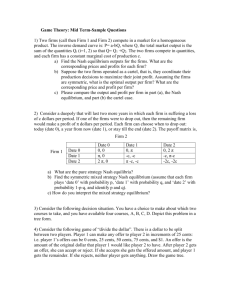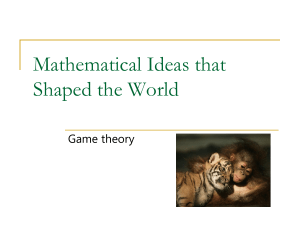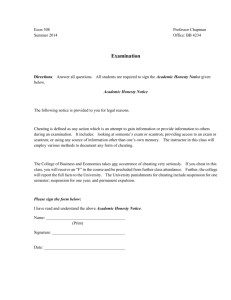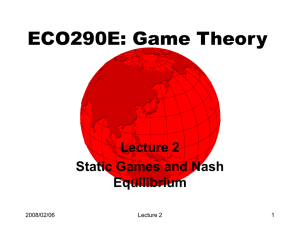Game Theory - Abernathy-ApEconomics-MPHS
advertisement
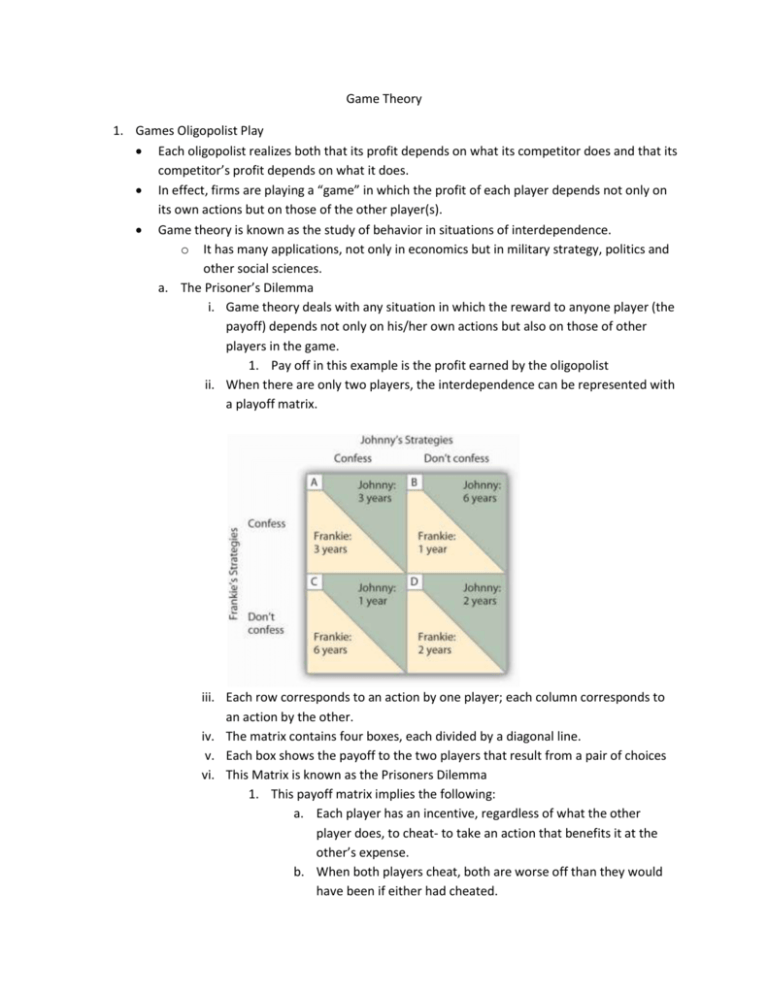
Game Theory 1. Games Oligopolist Play Each oligopolist realizes both that its profit depends on what its competitor does and that its competitor’s profit depends on what it does. In effect, firms are playing a “game” in which the profit of each player depends not only on its own actions but on those of the other player(s). Game theory is known as the study of behavior in situations of interdependence. o It has many applications, not only in economics but in military strategy, politics and other social sciences. a. The Prisoner’s Dilemma i. Game theory deals with any situation in which the reward to anyone player (the payoff) depends not only on his/her own actions but also on those of other players in the game. 1. Pay off in this example is the profit earned by the oligopolist ii. When there are only two players, the interdependence can be represented with a playoff matrix. iii. Each row corresponds to an action by one player; each column corresponds to an action by the other. iv. The matrix contains four boxes, each divided by a diagonal line. v. Each box shows the payoff to the two players that result from a pair of choices vi. This Matrix is known as the Prisoners Dilemma 1. This payoff matrix implies the following: a. Each player has an incentive, regardless of what the other player does, to cheat- to take an action that benefits it at the other’s expense. b. When both players cheat, both are worse off than they would have been if either had cheated. vii. Dominant Strategy 1. When it is the player’s best action regardless of the action taken by the other player. a. It is important to note that not all games have dominant strategy. It depends on the structure of payoffs in the game. viii. In a prisoners’ dilemma, each player has a clear incentive to act in a way that hurts the other player. When both make that choice, it leaves both of them worse off. ix. If both players make the same decision they have reached equilibrium of the game. 1. This equilibrium in game theory is known as a Nash equilibrium. x. Nash Equilibrium 1. It is named after mathematician and Nobel Laureate John Nash. 2. Because the players in a Nash equilibrium do not take into account the effect of their actions on others, this is known as a non-cooperative equilibrium. 3. In the prisoners’ dilemma, the Nash equilibrium happens to be an equilibrium of two dominant strategies- but Nash equilibrium can exist when there is no dominate strategy at all. b. Overcoming the Prisoners’ Dilemma: Repeated Interaction and Tacit Collusion i. The Prisoners’ Dilemma is known as a one-shot game- they play the game with each other only once. ii. Most of the games oligopolist plays aren’t one-shot games; instead, the players expect to play the game repeatedly with the same rivals. iii. A smart oligopolist doesn’t just decide what to do base on the effect on profit in the short run. It will engage in strategic behavior. 1. When a firm attempts to influence the future behavior of other firms. iv. Two types of strategies: 1. Always cheat 2. Tit for tat a. Involves playing cooperatively at first, then doing whatever the other player did in the previous period. b. It is intended to influence the future actions of other players. c. Offers a reward to the other player for cooperative behavior- if you behave cooperatively, so will I. v. If oligopolists expect to compete with each other over an extended period of time, each individual firm will conclude that it is in its own best interest to be helpful to the other firms in the industry. vi. Tacit collusion 1. When firms limit production and raise prices in a way that raises each other’s profits, even though they have not made any formal agreement.


